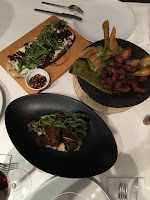This blog
post has a special topic on my recent holiday visit to the northern Mexican
city of Monterrey. Coming back from a two-week-long stay, I want to make a
small topical excursion and summarize my impressions on the cuisine of northern
Mexico. Monterrey is a large industrial center situated at the northern fringes
of the massive Sierra Madre Oriental mountain range that stretches from the
center of Mexico towards the US-Mexican border in the north. The large
mountains with their distinct peaks dominate the city-scape and gave Monterrey
its name as the king of mountains. A couple of hours away from the Texas
border, the city is one of Mexico’s main business centers and the country’s
second or third largest urban area (competing with Guadalajara).
The cuisine
in Monterrey can be characterized as northern Mexican, with its main feature of
being heavily beef based, and is very much distinct from central Mexican (more
pork) and southern/coastal Mexican (fish and tropical fruits). Northern Mexican
food relies on its cattle farming surrounding producing high quality beef and
having a strong ranch tradition among others leading to the output of a variety
of cheeses. On the other hand, the cuisine uses ingredients that are typical
for the whole country’s food, especially tomatoes, avocadoes, beans, chili and
habanero based salsas and corn and wheat tortillas.
During my
stay in Monterrey, I visited a couple of restaurants and I picked out a few
examples in order to give a quick overview of the regional food. One of our
first visits was for breakfast at Lázaro y Diego (link). It
can be taken as a typical Mexican breakfast, very heavy and filling for a
European stomach. I had bacon and sausages covered with cheese and topped with fried
tortilla pieces and mashed beans on the side. My wife ordered chilaquiles,
which is fried corn tortillas soaked in red and green sauce, topped with
chicken, cream and cheese. The typical Mexican breakfast is rich and of intense
flavor. Unlike European breakfasts, it is not sweet, but rather resembles a
lunch and can be even intensified with spicy salsas.
Now to the
most comprehensive symbol of Mexican cuisine: the taco. They are eaten at any
time, from a quick lunch snack to a proper dinner, and come with a wide range
of fillings, from beef cuts (e.g. arrachera), to pork (e.g. cochinita) and to
shrimps (camarón). Mixed in are different side ingredients with imagination
being the limit. Spicy salsas can be typically added as one prefers. Everything
is wrapped in either a wheat or corn tortilla. There are all kind of places
where one can get them: taco stands on the street, in fast food chains, in fine
dining restaurants. We went to a fantastic place called Chuchito Perez (link). We had the most memorable set of tacos of my
trip. My shrimp stuffed version was delicious, very juicy and refreshing. I
usually go for the corn tortilla since I love the taste of it and they are hard
to get in Europe.
Another day,
we went to a restaurant on the deck of a former steel foundry called El Lingote
(link). The retired steel mill stands in the center
of a now redeveloped industrial park in the heart of Monterrey and is symbolic
for the past and present industrial character of the city. The restaurant
boosted good food and great service. We ordered a few dishes to share. Among
them was a Monterrey classic: chicharrón de ribeye. This is fried beef cuts and usually comes
with guacamole. The name ribeye already indicates that usually the nice part of
the cow is used and therefore this dish is extremely delicious. Together with
guacamole, it is very nurturing food and indeed filled my stomach up quite
completely, even though it is typically serves as an ‘entrée’.
Finally, we
also visited other restaurants where the highlight was also a ribeye. Beef (and
also the related BBQ culture) is central to northern Mexican food culture. One
place was El Diego (link), which is actually an Argentinian restaurant.
Indeed, beef is loved so much that even finest beef is imported from south
America even though cattle farms are all around the neighboring regions of
Monterrey. My ribeye steak was very juicy and just plain delicious. Another occasion
was a visit to Mercurio (link), a fine dining restaurant in the upper-class
neighborhood of San Pedro. We had a 1200g ribeye cut with bone, which we shared.
The crust was nicely salty and the meat very tender. Overall, I loaded up so
much beef during my holidays in Mexico that I had enough for the rest of the
year. My highlights of northern Mexican food: delicious (corn) tacos and beef
with a price-quality ratio nowhere to be found in Europe.








Keine Kommentare:
Kommentar veröffentlichen